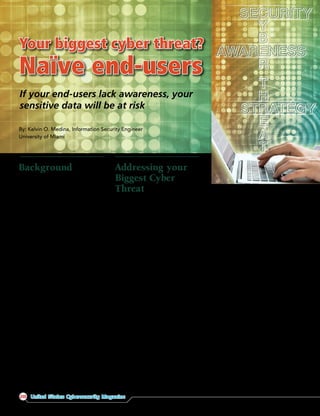The document discusses how approximately 50% of security breaches in the Federal Government are caused by a lack of user compliance. While security technologies have improved, end-user behavior can undermine security efforts if users are not properly educated. The biggest cyber threat organizations face is naïve end-users. It is important for organizations to develop cyber awareness programs to modify user behavior and make users the first line of defense against threats. These programs should use clear, non-technical language and involve listening to end-users to address weaknesses in security.

![reach all levels of an organization.
The National Cyber Security Alliance,
through it’s StaySafeOnline.org
portal, offer a series of free resources
to get started on the right track.
General cyber awareness, while
effective, is only half of the solution to
a bigger problem. According to the
2014 Internet Security Threat Report
reported by Symantec, targeted spear
phishing campaigns have increased
91% when compared to 2013.2
As a consequence, those end-users
with additional privileges within an
organization, now more than ever,
need advanced training based on
their role.
Going Beyond
End-User Awareness
Embedding cybersecurity an
organization’s policies, processes,
and procedures is one-step further
end-user awareness. For instance,
if end-users are able, as many are,
to acquire products and/or services
then this could introduce new
vulnerabilities into the environment.
It is then recommended to establish a
risk assessment process and attach the
same into the acquisition workflow.
This will give organizations an edge
in preventing the introduction of new
vulnerabilities into their information
systems before it becomes too late.
And as a good practice taken from
the systems engineering field, the
earlier cyber security requirements
get taken into consideration during
the System Development Life Cycle
(SDLC), the easier it will be to bring
the project back into compliance.
2 Internet Security Threat Report 2014. (2014). 1st
ed. [ebook] Mountain View: Symantec Corporation
World Headquarters. Available at: http://www.
symantec.com/content/en/us/enterprise/other_
resources/b-istr_main_report_v19_21291018.en-us.pdf
[Accessed 30 Oct. 2014].
Summing up:
Developing a comprehensive cyber
awareness program is not by any
means a one-person task or even
a responsibility residing within
the technology department of an
organization. It requires the effort
and dedication of many people
with good intentions. From leaders
at the top, to anyone in between,
embracing the awareness message
is everyone’s job.
At the end, it is not all about pouring
resources into new technologies but
coupling them with an organizational
culture that cares. That will determine
to a greater extent, the success of any
security program.
Kelvin O. Medina, CISSP,
SEC+, ITIL, is currently
an Information Security
Engineer at the University
of Miami. He received a
BS in Computer Science
from University of Puerto
Rico and a MS in Technical Management
from the Johns Hopkins University.
Previously, he worked for almost four
years for the US Navy at Dahlgren, VA
as Information Systems Security Officer
(ISSO). In his free time, he enjoys going
to the beach and learning about the latest
in the technology field.
General cyber
awareness,
while effective,
is only half of
the solution to a
bigger problem.
29United States Cybersecurity Magazine](https://image.slidesharecdn.com/d93bca46-061a-4417-8a3b-a4995eadb8cc-160115182312/85/University-of-Miami_MEDINA-2-320.jpg)